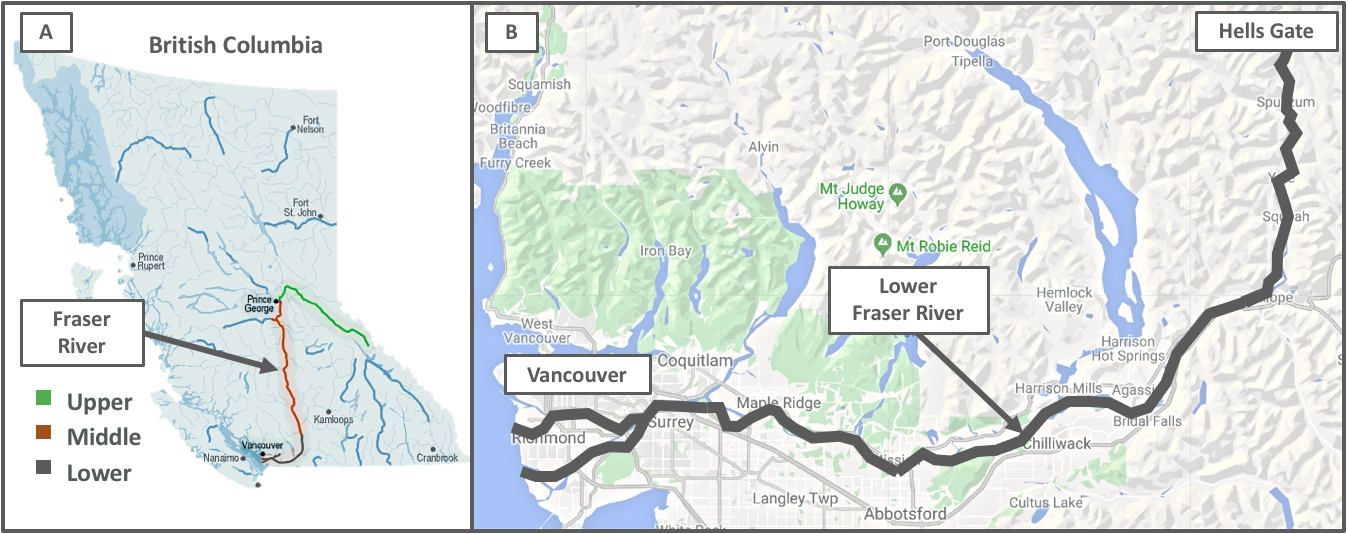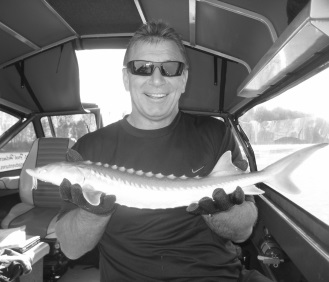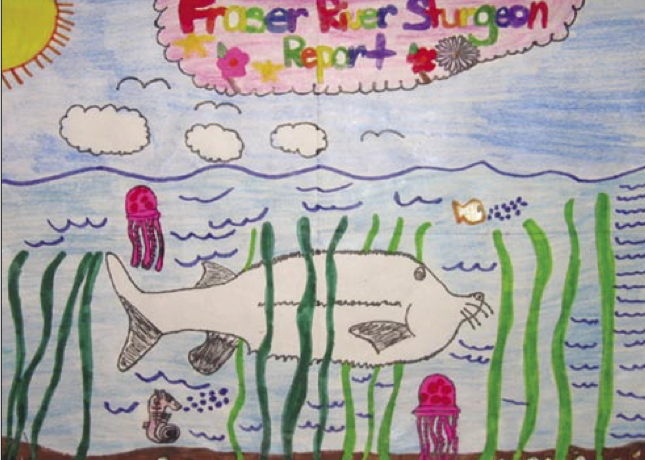SOS— Save Our Sturgeons!
Prepared by Zaynah Kahn, Charlotte Matthews, and Tamara Walton
Deep in the muddy rivers of western North America lives a prehistoric giant—the white sturgeon. Having evolved nearly 175 million years ago, this fish has many primitive features, including a long scale-less body lined with rows of bony plates. But sturgeons are best known for their impressive size. When fully grown, they are nearly as long as killer whales and more than three times longer than the average human! (Figure 1)

Today, the world’s largest population of white sturgeons lives in British Columbia’s (BC) Lower Fraser River. This region stretches from the mouth of the Fraser to Hells Gate and contains nearly 35,000 sturgeons (Figure 2).

Dwindling Stocks

Although it may be the world’s largest, the Lower Fraser white sturgeon population is well-below historic levels. In the late 1800s, this population faced intense commercial fishing pressure— harvests were reaching nearly half a million kilograms each year! By 1900, the fishery had crashed and only one-tenth of the sturgeons remained. Their numbers dwindled even further in the 1900s, when sturgeons were regularly caught by anglers and as salmon fishery by-catch (Figure 3). Eventually, the Province of BC called for a ban on all white sturgeon fishing in 1994— with exception of catch-and-release angling (Figure 3).
Yet as we approach 2020, the Lower Fraser sturgeon population remains in decline. Current decreases are thought to be caused by habitat loss, river pollution, and injuries caused by catch-and-release angling. As a result, the population has been deemed Threatened by the Committee on the Status of Endangered Wildlife in Canada and listed as Imperiled by the BC Conservation Data Centre.
Why Should We Care?
White sturgeons have significant ecological value in the Lower Fraser River. They have an important role in the river’s food chain as they are both predator and prey to a variety of species (Figure 4).

Lower Fraser white sturgeons also have considerable economic value. Nearly one-tenth of the revenue generated by BC freshwater sport-fishing comes from white sturgeon angling. Lastly, white sturgeons in the Lower Fraser have significant cultural value. They have been historically important to many First Nations communities in BC as a source of food. Although most First Nations groups no longer harvest white sturgeons, they continue to appreciate the species as a component of healthy ecosystems. Similar views are held by the general public, which have increasingly appreciated the species’ intrinsic and ecological values.
Sturgeon Stewardship

In 1997, a diverse group of white sturgeon enthusiasts from BC came together to form the Fraser River Sturgeon Conservation Society (FRSCS). This society is a non-profit organization dedicated to the conservation and restoration of Lower Fraser white sturgeons. It was founded by Rick Hansen and is run by a combination of scientists, conservationists, and angling guide operators (Figure 5).
Since its formation, the FRSCS has implemented four major initiatives to monitor, research, and raise public awareness for Lower Fraser white sturgeon and their habitat (Figure 6). The FRSCS receives funding for these projects through charitable foundations, government agencies and direct donations from individuals.

So, just how successful have these initiatives been in conserving white sturgeon and getting people to care about their survival? Continue reading to find out…
FRSCS: Successes & Shortcomings
Monitoring and Assessment Program

For almost 20 years now, the FRSCS has been monitoring the Lower Fraser sturgeon population using PIT tags (think microchips). Now, tagging sturgeon is no simple task; they are highly mobile and tend to be difficult to capture (they can weigh over 600 kg!). So, the FRSCS has created a volunteer program in which experienced fishers catch sturgeon, tag them for tracking, and release them back into the Fraser (Figure 7).
Since the start of the program, volunteers have tagged nearly 70,000 white sturgeons for the FRSCS program! These efforts have allowed the society to see where sturgeons travel throughout the year and confirm that their population is declining (especially the young ones!). The data produced from this project has also helped guide many of the FRSCS’s conservation initiatives, such as the Habitat Surveys (read below). We encourage the FRSCS to continue implementing this program and using the data to direct future conservation decisions and monitor their success.
Habitat Surveys
The data from the Monitoring and Assessment Program showed there was a real problem— the number of young white sturgeons was declining. This could be because of two reasons:
- Young white sturgeons (AKA juveniles) were not able to find suitable habitats where they could grow, eat, and hide from predators
- The adult white sturgeons were not laying eggs (AKA spawning) and very few sturgeons were being born
The FRSCS teamed up with scientists and volunteers to investigate. Through years of research on the Lower Fraser River, the FRSCS identified important sturgeon juvenile habitats and spawning grounds.

Two important juvenile habitats they found were the Matsqui Channel, near the City of Abbotsford, and the Hatzic Eddy, near the City of Mission (Figure 9). Though the sites were identified, nothing has been done to keep them safe. Increasing boat traffic, especially near the Hatzic Eddy, means the juvenile habitats might be disrupted. On top of that, the City of Abbotsford is planning to expand its sewage treatment plant (Figure 9). This means more harmful wastes will be flowing into the Matsqui Channel, further threatening to destroy a very important space for juvenile sturgeon.
The spawning sites tell a similar story, which face serious threats due to lack of protection. Forests have been cut down and farms have been set up along the Fraser River, meaning lots of excess debris (like fine gravels) and agricultural wastes flow through the spawning sites. This disrupts both the health of spawning sturgeons and the places where they lay eggs. Another threat is catch-and-release angling, which stresses adult white sturgeons to the point where they stop laying eggs. Fortunately, the FRSCS is working to fix this problem by setting up sturgeon sanctuaries near the spawning sites. No angling will be allowed in these sanctuaries, which will help ensure spawning sturgeons are the least stressed as possible and continue to lay eggs. We encourage the FRSCS to follow through with this plan and expand their efforts to include preventing debris from entering the Lower Fraser River.
Sturgeon Education Program

In 2006, the FRSCS launched the Sturgeon Education Program (SEP), which uses the iconic white sturgeon to teach students the rationale for environmental protection and smart resource management. The students use this knowledge to create sturgeon stewardship programs—which can take the form of reports, murals, or videos (Figure 8).
So far, the SEP has reached over 200,000 students across BC and Ontario and had lasting effects. MacPhareson—who has taught the SEP multiple times at False Creek Elementary—says that her students form deep connections with white sturgeon and a desire to keep them safe. She even notes that many of her “graduates visit to tell [her] some sturgeon fact from the news”. One short-coming of the SEP, however, is that it lacks a meaningful evaluation plan. This means the FRSCS cannot actually tell whether all of the desired learning outcomes are being met. For this reason, we recommend the FRSCS works to establish an effective evaluation plan for the SEP. This could be achieved by making the current Teacher Feedback Form more detailed and by organizing regular class room sit-ins— in which a FRSCS member would join in on a SEP teaching day and experience student responses first-hand.
Angling guidelines
Drawn by their enormous size, the number of sturgeon anglers on the Fraser has skyrocketed over the past years. Naturally, there have been growing concerns over the ability of anglers to handle the delicate beasts. To ease these concerns, the FRSCS teamed up with the BC Government, the Fraser Valley Angling Guides Association, and the Recreational Sturgeon Anglers of BC to produce guidelines for angling sturgeon in BC waters. They also produced Can You Handle It, an educational video based on the guidelines—which you can watch here:
The guidelines cover everything from fishing gear to taking photos and aim to minimize damage to sturgeon from angling and raise angler awareness about sturgeon conservation. So far, sturgeon anglers from across BC have been quick to incorporate the guidelines into their fishing practices and adopt a culture geared towards conservation. With such strong support from the angling community, we encourage the FRSCS to continue updating the guidelines as new information about best handling practices becomes available.
Unfortunately, the success of the guidelines is cut-off at Mission Bridge, where the Fraser’s waters shift from provincial control to federal (Figure 10). The Government of Canada only enforces a handful of restrictions on white sturgeon angling, meaning the majority of the Fraser River population could still be exposed to harmful angling practices.

Overall, the FRSCS has made great strides in gathering information about the Lower Fraser white sturgeon and generating awareness for this vulnerable species. However, there is still much room for improvement: habitats need protecting, education programs need evaluation, and best handling practices need to be adopted by all.
What Can I Do To Help White Sturgeons?
Great news: you don’t have to be an environmental scientist to help conserve this vulnerable species! The best way forward is to make your voice heard. You can contact the Department of Fisheries and Oceans (DFO) in Canada and let them know you want angling guidelines enforced in federal waters— call them at 604-814-1055 or send an email to min@dfo-mpo.gc.ca. If you want to go outdoors and experience the great white sturgeon in nature, do so by volunteering to be a tagger for the FRSCS! Contact the FRSCS for more information on how to sign up. If you’d rather show your appreciation in a different way, you can always Adopt A Sturgeon and get loads of information about your adopted fish as it journeys through the vast Lower Fraser River. If none of those options work for you, simply sharing this blog post can help bring more awareness to the majesty and plight of BC’s very own white sturgeon!
Interested in learning more? Here are some extra links to explore:
Catch-and-release angling recently banned during the spawning period until 2021
Two dead sturgeon found in polluted lake near Hatzic Eddy in 2018
What’s going on on Herrling Island?

 Follow
Follow